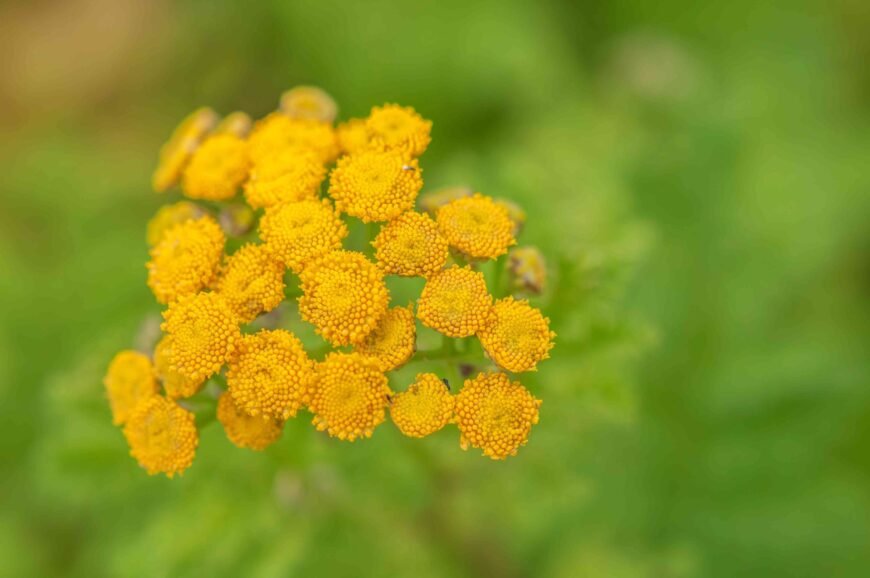| Common Names | Common tansy, bitter buttons, cow bitter, golden buttons |
| Botanical Name | Tanacetum vulgare |
| Plant Type | Perennial, herbaceous |
| Mature Size | 2-5 ft. tall, 12-18 in. wide |
| Soil Type | Well-drained |
| Bloom Time | Summer |
| Flower Color | Yellow |
| Hardiness Zones | 3-8 (USDA) |
| Native Area | Europe, Asia |
| Toxicity | Toxic to humans, dogs, and livestock |
Common Tansy Invasiveness
Warning
Common tansy has been listed by watchdog groups as one of the worst invasive plants in North America. The sale of its seeds is prohibited in Montana and Wyoming. The plant itself is prohibited to be sold or grown in Colorado, Minnesota, Montana, Wyoming, parts of Washington state, and the Alberta and British Columbia provinces in Canada.
Common tansy grows in full sun to part shade. Although it prefers moist, humus-rich soils, it can grow in a wide range, including dry, poor, and disturbed soils. It reproduces fast by seeds and rhizomatous roots. Once established, it forms a dense cover, choking out native vegetation that serves as food and shelter for native wildlife, thus affecting species diversity. One plant produces more than 2,000 seeds. Most seeds drop near the plant but can also be dispersed by wind and water.
Because common tansy grows in dense patches, it can clog drainage ditches. It also harms pastures, making them unfit for livestock, as common tansy is toxic to horses and cows. Because it grows so densely, the production of forage plants that livestock can feed on is significantly reduced.
How to Identify Common Tansy
Tansy has three to six vertical stems that are brown to reddish-brown or purplish-red at the base. The plant has green, fern-like, or feathery alternate leaves. When crushed, the leaves give off a pungent camphor-like odor, which makes it easy to identify the plant. The heavily scented leaves of common tansy act as an insect repellent, so the plant is not vulnerable to pests or disease–another factor that favors its survival and uncontrolled spreading.
From July to September, common tansy has bright golden or yellow button-like blooms, 14 to 12 inch wide, that grow in flat-topped flower clusters up to 4 inches wide. The flowers turn into tiny dark brown seed heads in late summer to fall, from which the plant reseeds prolifically.
How to Get Rid of Common Tansy
Individual plants or small patches of common tansy can be removed manually, but they require a shovel since the roots are deep. Removing the roots is crucial, as the plant will regrow from root fragments. Wear gloves when touching the plants, as the leaves can cause contact dermatitis.
A broad-spectrum herbicide should only be used if the infestation is so large that it cannot be managed by manual removal. When using chemical herbicides, target the plants to be removed, avoid drifting, and wear protective clothing, gloves, and goggles. Mowing an infestation can weaken the plants before applying herbicide to the regrowth and will lessen the amount you need. But be careful to time the mowing before seed production, or it will only spread the seeds.
How to Prevent Common Tansy From Spreading
Whatever removal method you use, get rid of the plants before they set seed, either before or during the summer flowering period. If you remove common tansy in the late summer or fall after the seed heads have already developed, new plants will germinate the next year.
Common Tansy vs. Tansy Ragwort
The flowers of tansy ragwort (Senecio jacobea) are very different than the button-like flowers of common tansy. Tansy ragwort has flowers resembling yellow daisies with 13-ray petals and yellow centers. Both plants are noxious invasive weeds.
-
-
Tansy flower was traditionally used to make different medicines. Research supporting medicinal uses is sparse, and it is primarily considered toxic.
-
-
-
Historically, the tansy plant was used as an insecticide. Recent research suggests that distilled oil from the plant is effective in repelling mosquitos.
-
-
-
Due to its toxic properties and tendency towards invasiveness, it’s probably best not to welcome common tansy into your garden.
-
